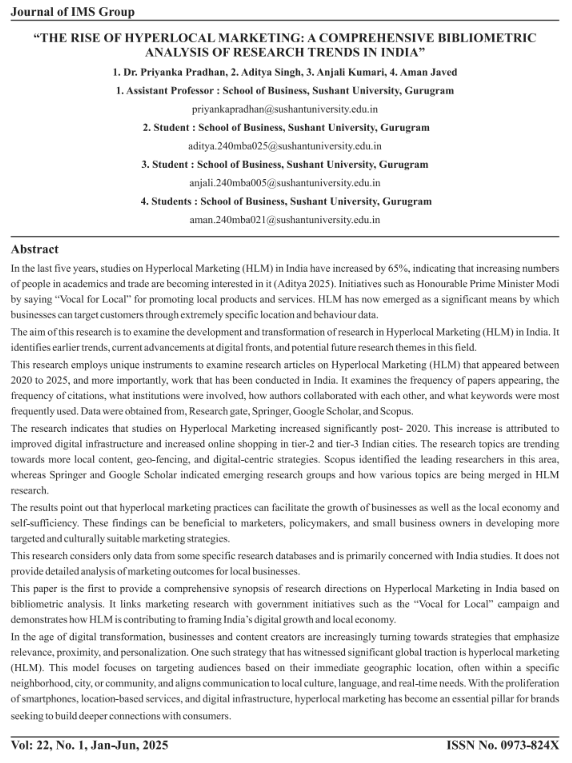THE RISE OF HYPERLOCAL MARKETING
A COMPREHENSIVE BIBLIOMETRIC ANALYSIS OF RESEARCH TRENDS IN INDIA
Keywords:
INDIA, BIBLIOMETRIC ANALYSIS, LOCAL CULTURE, HYPERLOCAL MARKETING, EDUCATION SECTOR, HYPERLOCAL DELIVERY, E-COMMERCEAbstract
In the last five years, studies on Hyperlocal Marketing (HLM) in India have increased by 65%, indicating that increasing numbers of people in academics and trade are becoming interested in it (Aditya 2025). Initiatives such as Honourable Prime Minister Modi by saying "Vocal for Local" for promoting local products and services. HLM has now emerged as a significant means by which businesses can target customers through extremely specific location and behaviour data.
The aim of this research is to examine the development and transformation of research in Hyperlocal Marketing (HLM) in India. It identifies earlier trends, current advancements at digital fronts, and potential future research themes in this field.
This research employs unique instruments to examine research articles on Hyperlocal Marketing (HLM) that appeared between 2020 to 2025, and more importantly, work that has been conducted in India. It examines the frequency of papers appearing, the frequency of citations, what institutions were involved, how authors collaborated with each other, and what keywords were most frequently used. Data were obtained from, Research gate, Springer, Google Scholar, and Scopus.
The research indicates that studies on Hyperlocal Marketing increased significantly post- 2020. This increase is attributed to improved digital infrastructure and increased online shopping in tier-2 and tier-3 Indian cities. The research topics are trending towards more local content, geo-fencing, and digital-centric strategies. Scopus identified the leading researchers in this area, whereas Springer and Google Scholar indicated emerging research groups and how various topics are being merged in HLM
research.
The results point out that hyperlocal marketing practices can facilitate the growth of businesses as well as the local economy and self-sufficiency. These findings can be beneficial to marketers, policymakers, and small business owners in developing more targeted and culturally suitable marketing strategies.
This research considers only data from some specific research databases and is primarily concerned with India studies. It does not provide detailed analysis of marketing outcomes for local businesses.
This paper is the first to provide a comprehensive synopsis of research directions on Hyperlocal Marketing in India based on bibliometric analysis. It links marketing research with government initiatives such as the "Vocal for Local" campaign and demonstrates how HLM is contributing to framing India's digital growth and local economy.
In the age of digital transformation, businesses and content creators are increasingly turning towards strategies that emphasize relevance, proximity, and personalization. One such strategy that has witnessed significant global traction is hyperlocal marketing (HLM). This model focuses on targeting audiences based on their immediate geographic location, often within a specific neighborhood, city, or community, and aligns communication to local culture, language, and real-time needs. With the proliferation of smartphones, location-based services, and digital infrastructure, hyperlocal marketing has become an essential pillar for brands
seeking to build deeper connections with consumers.



